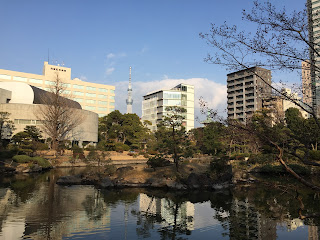It snowed in Tokyo today, just when I had decided to wear leather shoes.
True, the weather forecast had said "Snow 100%" when I checked it that morning, but I simply couldn't believe it: in the entire winter I'd spent in Tokyo six years ago not once had it even sort of maybe hinted at snow. But by 1pm it was snowing big, fat, damp flakes of snow that quickly piled up on the sidewalks and in the streets. I was told to go home early from my first day at my new job (what a day!), and since it took me nearly two hours to get back to my apartment that was certainly the right call.
Hard to believe that only two days ago it was nearly 50 degrees (Fahrenheit, I'm still a US girl at heart, here, even if I now live in 24-hour time) and I was walking through a sunny Japanese garden.
The Kyuyasuda garden is located in the Ryogoku area of Sumida-ku, in the Eastern half of Tokyo. It's an area famous for sumo, and the park is nestled against the grounds of the "Ryogoku kokugikan," or "Ryogoku Sumo Hall." The garden, which used to belong to a samurai family, is small but well-tended and popular, apparently, for wedding photos. Indeed, there's a very picturesque bridge, painted over in red and orange, that seemed to be a popular photo spot.
However, the main purpose of the visit was less the garden and more the brand new (opened only on January 18, 2018!) sword museum:
I was accompanied by Ms Naomi Pollock, a professional writer specializing in Japanese architecture. You can check out her website HERE and her instagram HERE. It's amazing how traveling with someone who is an expert in their field improves your own experience, because they can point out all the little details you would have otherwise glossed over.
Some tidbits I can provide:
The building was designed by Pritzker Prize-winning architect Fumihiko Maki. The first floor, which is primarily a public community space, is designed with curves and mellowed-metallic finishes. As you move to the stairs, however, the angles and materials become sharper and harsher until you come to the second floor exhibit space. It's truly designed to highlight the dozens of swords, hilts, scabbards, and accessories, which seem to glow underneath pinpoint lighting.
The Society for the Preservation of Japanese Art Swords really has a spectacular collection, and that includes modern swords as well as ancient heirlooms. They also had specific categories for sword making versus sword carving versus even sword polishing. Each aspect of the craft could and did have masters dedicated to that single element. It's mind boggling, to a certain extent, but amazing. The detail is really spectacular, and next time I'll have to go with a sword expert so I can learn a bit more about this truly sharp (hehehe) aspect of Japanese art.
Now, if only the snow would stop so I could get there...
True, the weather forecast had said "Snow 100%" when I checked it that morning, but I simply couldn't believe it: in the entire winter I'd spent in Tokyo six years ago not once had it even sort of maybe hinted at snow. But by 1pm it was snowing big, fat, damp flakes of snow that quickly piled up on the sidewalks and in the streets. I was told to go home early from my first day at my new job (what a day!), and since it took me nearly two hours to get back to my apartment that was certainly the right call.
Hard to believe that only two days ago it was nearly 50 degrees (Fahrenheit, I'm still a US girl at heart, here, even if I now live in 24-hour time) and I was walking through a sunny Japanese garden.
The Kyuyasuda garden is located in the Ryogoku area of Sumida-ku, in the Eastern half of Tokyo. It's an area famous for sumo, and the park is nestled against the grounds of the "Ryogoku kokugikan," or "Ryogoku Sumo Hall." The garden, which used to belong to a samurai family, is small but well-tended and popular, apparently, for wedding photos. Indeed, there's a very picturesque bridge, painted over in red and orange, that seemed to be a popular photo spot.
However, the main purpose of the visit was less the garden and more the brand new (opened only on January 18, 2018!) sword museum:
I was accompanied by Ms Naomi Pollock, a professional writer specializing in Japanese architecture. You can check out her website HERE and her instagram HERE. It's amazing how traveling with someone who is an expert in their field improves your own experience, because they can point out all the little details you would have otherwise glossed over.
Some tidbits I can provide:
The building was designed by Pritzker Prize-winning architect Fumihiko Maki. The first floor, which is primarily a public community space, is designed with curves and mellowed-metallic finishes. As you move to the stairs, however, the angles and materials become sharper and harsher until you come to the second floor exhibit space. It's truly designed to highlight the dozens of swords, hilts, scabbards, and accessories, which seem to glow underneath pinpoint lighting.
The Society for the Preservation of Japanese Art Swords really has a spectacular collection, and that includes modern swords as well as ancient heirlooms. They also had specific categories for sword making versus sword carving versus even sword polishing. Each aspect of the craft could and did have masters dedicated to that single element. It's mind boggling, to a certain extent, but amazing. The detail is really spectacular, and next time I'll have to go with a sword expert so I can learn a bit more about this truly sharp (hehehe) aspect of Japanese art.
Now, if only the snow would stop so I could get there...










Comments
Post a Comment